In this article:
- Determine the vision for your business
- Delegate your team’s responsibilities
- Identify your target client
- Identify your overall goals
- Craft a unique selling proposition
- Complete a SWOT analysis
- Perform a competitive analysis
- Use all effective marketing strategies
- Create a marketing calendar
- Calculate the return on lead generation
- Document ways to convert leads
- Project yearly sales forecasts
- Measure client experience
- Calculate your marketing plan performance
- Free real estate marketing plan template
A real estate marketing plan is a document that outlines your sales goals for the year by establishing a detailed budget, your target audience, marketing and advertising plans, and other strategies to grow your business.
Bret Calltharp, a real estate agent trainer, says “a real estate marketing plan reinforces your unique value proposition and helps determine what tangible actions you’re taking that other agents in your market are not.” It allows you to differentiate yourself from the competition, track what works best and see where you can improve. A marketing plan will identify:
- The right tools and messages to effectively reach your audience
- Ways to better serve your clients
- Where you want your business to be and how you’ll get there
- How to measure the performance of your marketing efforts
- How to recognize when and where you need to make a course correction
Let’s look at what goes into a marketing plan and why each item is important to your success.
Determine the vision for your business
This is the backbone of your entire real estate marketing plan. What do you want to achieve in the short term and in the long term? Create a brief statement describing the service you’ll provide to make clients eager to work with you.
Example: Our company will change the way [target customers] think about the real estate market. How we provide [service], [service] and [service] will assure them that we are the best partners in real estate.
Delegate your team’s responsibilities
Create a list of your team members and their individual roles and responsibilities. This ensures all areas of business are accounted for and eliminates any confusion and overlap. Here’s an example from our download:
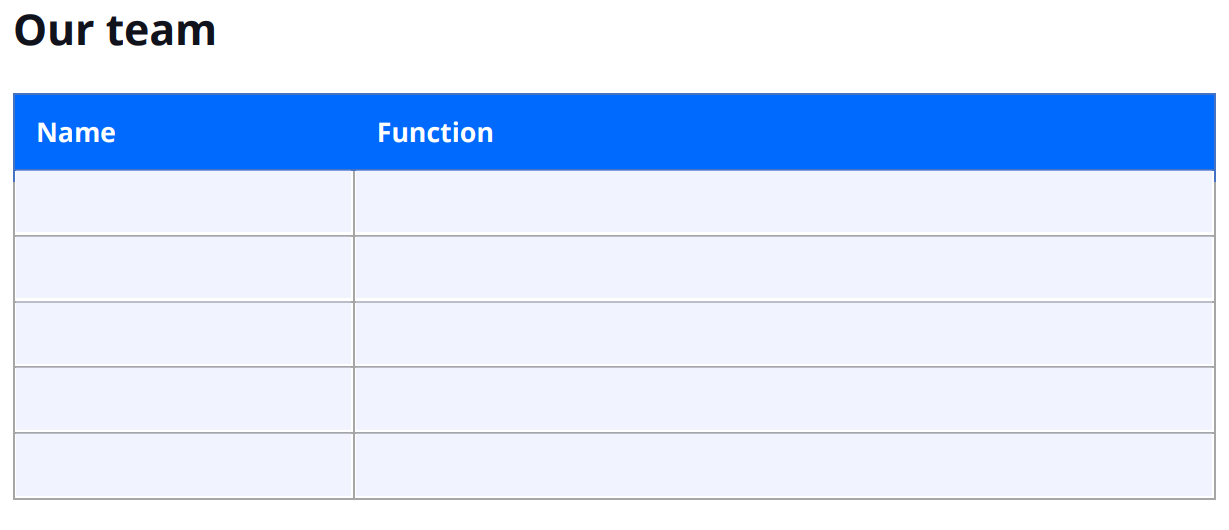
Identify your target client
Understanding your audience is vital to developing a successful marketing strategy. Is your target client a first-time home buyer, a home seller or a renter? Or are you targeting a more specific subset like relocators, retirees or investors?
What is your target client’s persona?
Once you know who you’re targeting, you can further develop their persona. These important details will make your real estate marketing strategy effective and efficient (remember to follow all applicable fair housing laws in your area). Here are some questions to help establish your client’s persona:
- Where do they want to live?
- How old are they?
- What is their annual household income?
- What is the household makeup?
- What do they want from their home?
- What are their feelings and concerns about searching for and purchasing their home?
What do you want your target client to think of you?
After a client receives your marketing message, how do you want them to perceive your business? Draft a sentence or two describing the ideal scenario.
How do you want your target client to act?
Do you want them to schedule an appointment? Call for more information? Knowing the desired action in advance can save you time, money and effort when forming and implementing a marketing strategy.
Identify your overall goals
There are three types of real estate marketing goals: Business, strategic and tactical.
Business goals
What does success look like for the business? Is it establishing a number of new clients? Obtaining a number of referrals from past/present clients? Hitting a certain sales figure? Make sure your goals are realistic and achievable.
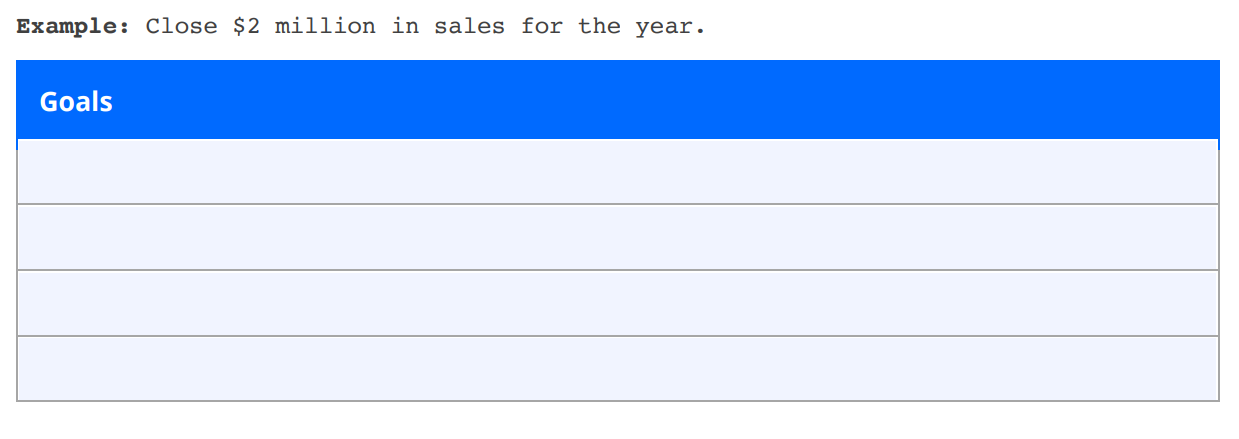
Strategic goals
What are your strategies for achieving your business goals? Write strategic goals next to your business goals. Example:

Tactical goals
You’ll use these tactics to accomplish your strategic goals, which will in turn lead to achieving your business goals. Example:

Craft a unique selling proposition
A unique selling proposition, or USP, differentiates you from your competition. It’s the most important thing a real estate agent needs for a successful marketing plan. Consider your target client and the challenges they face — how can you provide a solution to their problem and how much are you willing to spend to do so? See what your competitors are doing and offer a better solution. Example:
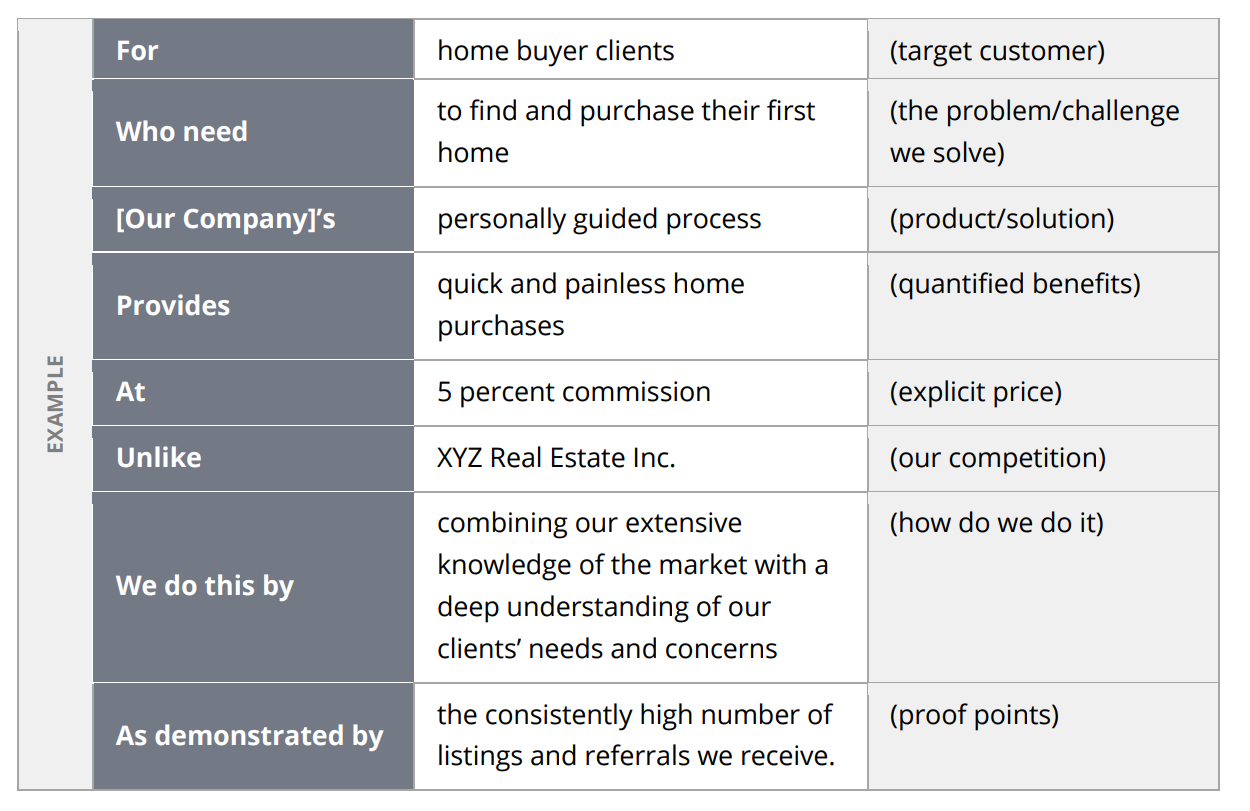
What differentiates you from your competition?
Map out qualities that make your business unique — then explain why they work and how to improve upon them. Example:
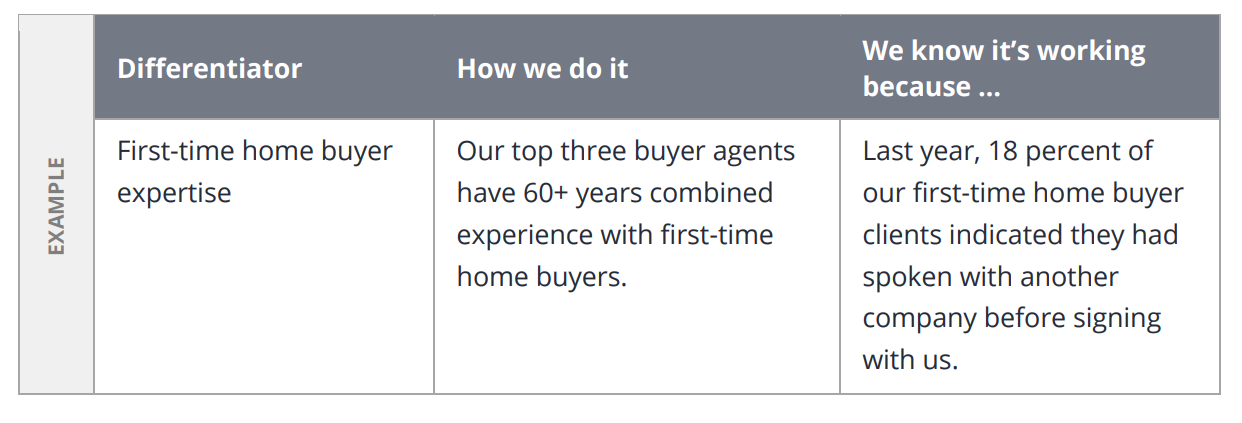
What steps do you take to maintain your differentiation?
List at least three ways to maintain your USP. Example:

Complete a SWOT analysis
Determine your strengths, opportunities, weaknesses and threats to help understand the viability of your goals. Example:

Use the analysis results to your advantage
Write out a plan to leverage your strengths, overcome your weaknesses, capitalize on your opportunities and eliminate your threats. Example:

Perform a competitive analysis
Assess your competitors’ strengths and weaknesses and write them down. Example:

Monitor your competitors’ performance
Observe what they do and how they’re doing it. You may also want to look at their past performance, including:
- How many closing sales they have per year
- The average list price they work with
- Their percentage of the market (from the MLS)
Evaluate competitors’ marketing efforts
How are they advertising and branding themselves? Look closely at their efforts — especially those within your farm area:
How is their website structured? Check whether it’s driving leads and what types of ads they’re using.
How are their listings formatted? Look on Zillow and see what images and words they use to attract buyers.
Are they a Zillow Premier Agent? They’ll have a distinct advantage if so — because Zillow Premier Agents are automatically connected with active buyers and sellers.
Are they using print ads? Read the ad section in your paper and flip through local real estate books to see what they’re doing and who they’re targeting.
How are they marketing on social media? See if they’re advertising on Facebook and what groups they’re targeting. Familiarize yourself with their posts, topics and how they brand themselves — and pay attention to how many followers they have.
Are they using Google Ads? Find out what keywords they’re using and the demographics or interests they’re targeting.
What branding are they using? Go around town — look at billboards, flyers and other marketing tactics. Do they have a theme or catchy slogan? Are people talking about them?
Capitalize on your competitors’ weaknesses
Once you’ve analyzed the competition, you can develop a plan to outperform by pinpointing areas they’re missing or where they aren’t being effective. Example:
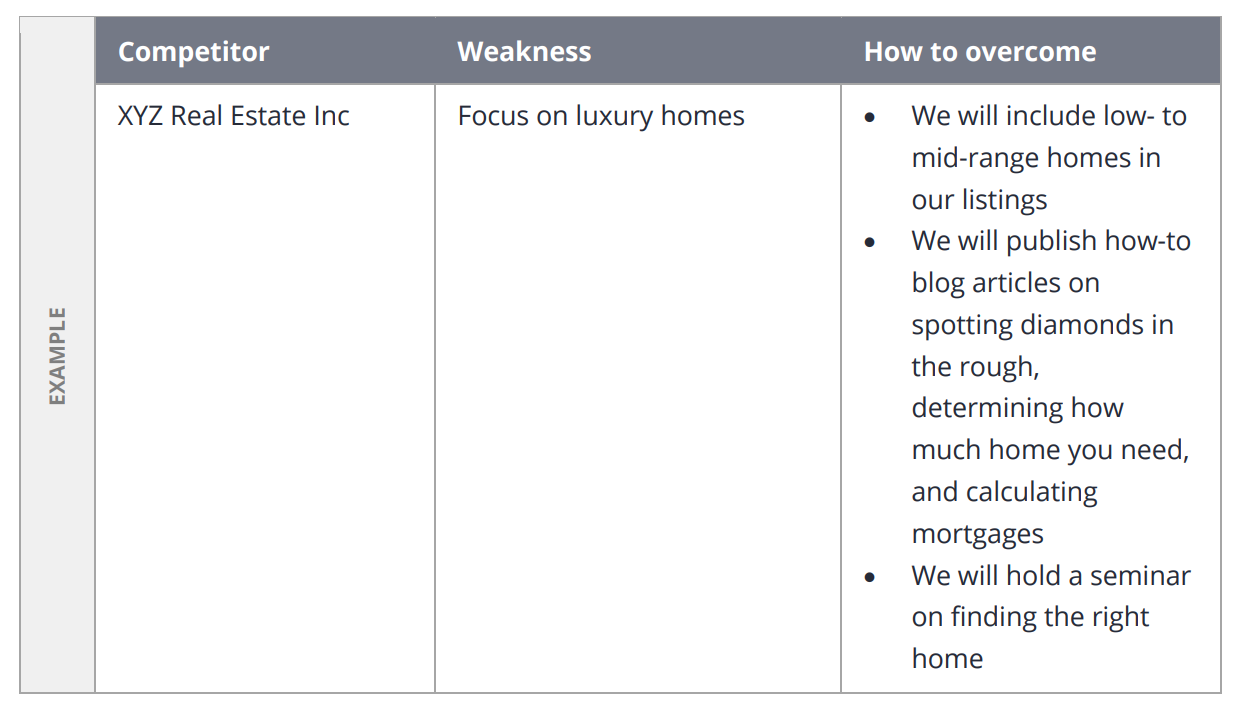
Use all effective marketing strategies
Determine what real estate marketing strategy — or mix of strategies — will best reach your target audience. Set aside a budget and note when you should update and adjust. Example:
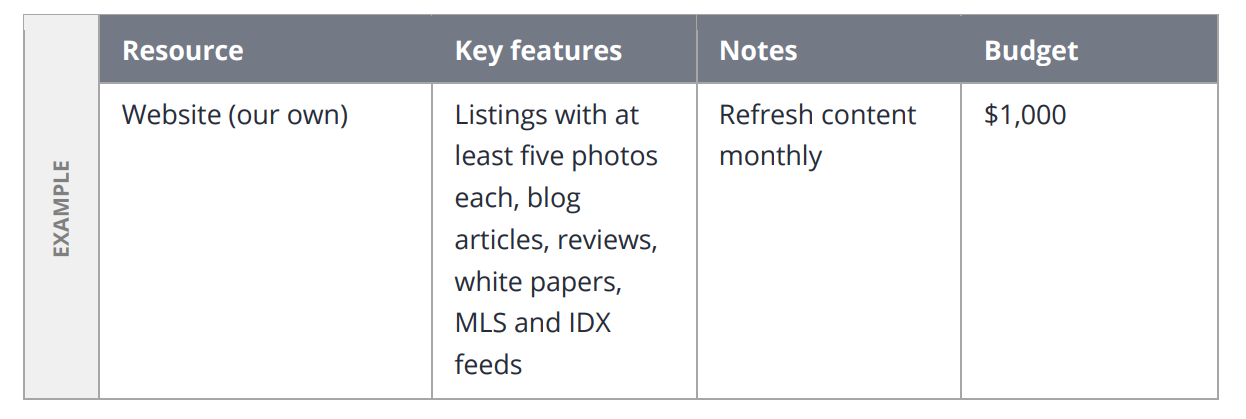
Popular marketing channels include websites, blogs, social media, emails, newspaper ads, postcards, signage, business cards, flyers, door hangers, newsletters and videos. According to the Zillow Group Consumer Housing Trends Report 2018, these are the most effective real estate marketing ideas:
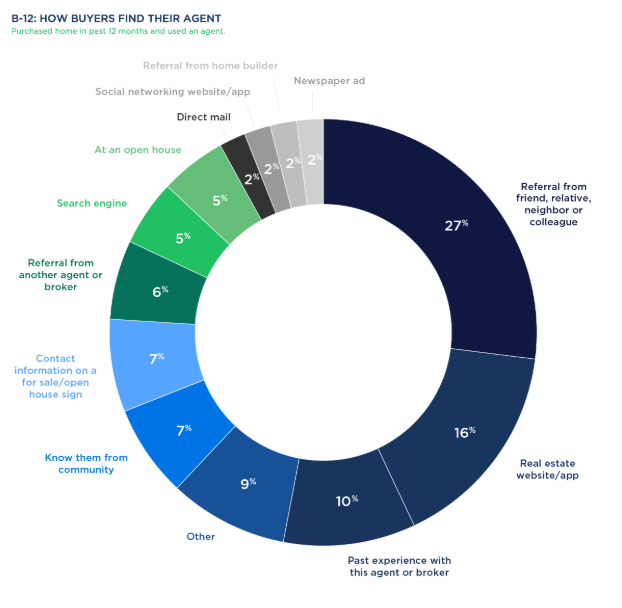
Create a marketing calendar
Organization and consistency are key when creating a marketing plan for real estate. A marketing calendar keeps you on track and ensures you’re meeting deadlines. Your calendar should include your marketing strategy, cadence and target audience.
Blog posts: Content should be published three times per week and always be relevant to your local area. Topics can include nearby attractions and market updates.
Cold calling: Set aside time each day to reach out about for-sale-by-owner properties, expired listings and other prospects — and have a phone script ready to ensure you’re being as effective as possible.
Email campaigns: Send an email to your target clients once or twice a month. Track which days of the week you receive the best response rates and adjust accordingly.
Social media posts: Use Facebook and Twitter to share local market updates. Instagram is useful to showcase walkthroughs of new properties.
Assign a marketing calendar lead
You can manage the marketing creation yourself or delegate the responsibility to someone on your team. The marketing lead needs to consistently update the calendar and ensure that real estate marketing goals are met.
Develop marketing milestones
These can be monthly, bimonthly or yearly goals depending on the channel and the goal. For example:
- Generate a 50% increase in website traffic for the year.
- Generate a 33% increase in leads through online methods each quarter.
Calculate the return on lead generation
Lead generation is the process of identifying and cultivating potential clients. Determine your most effective methods of lead generation and what kind of return you expect from them.
Example:
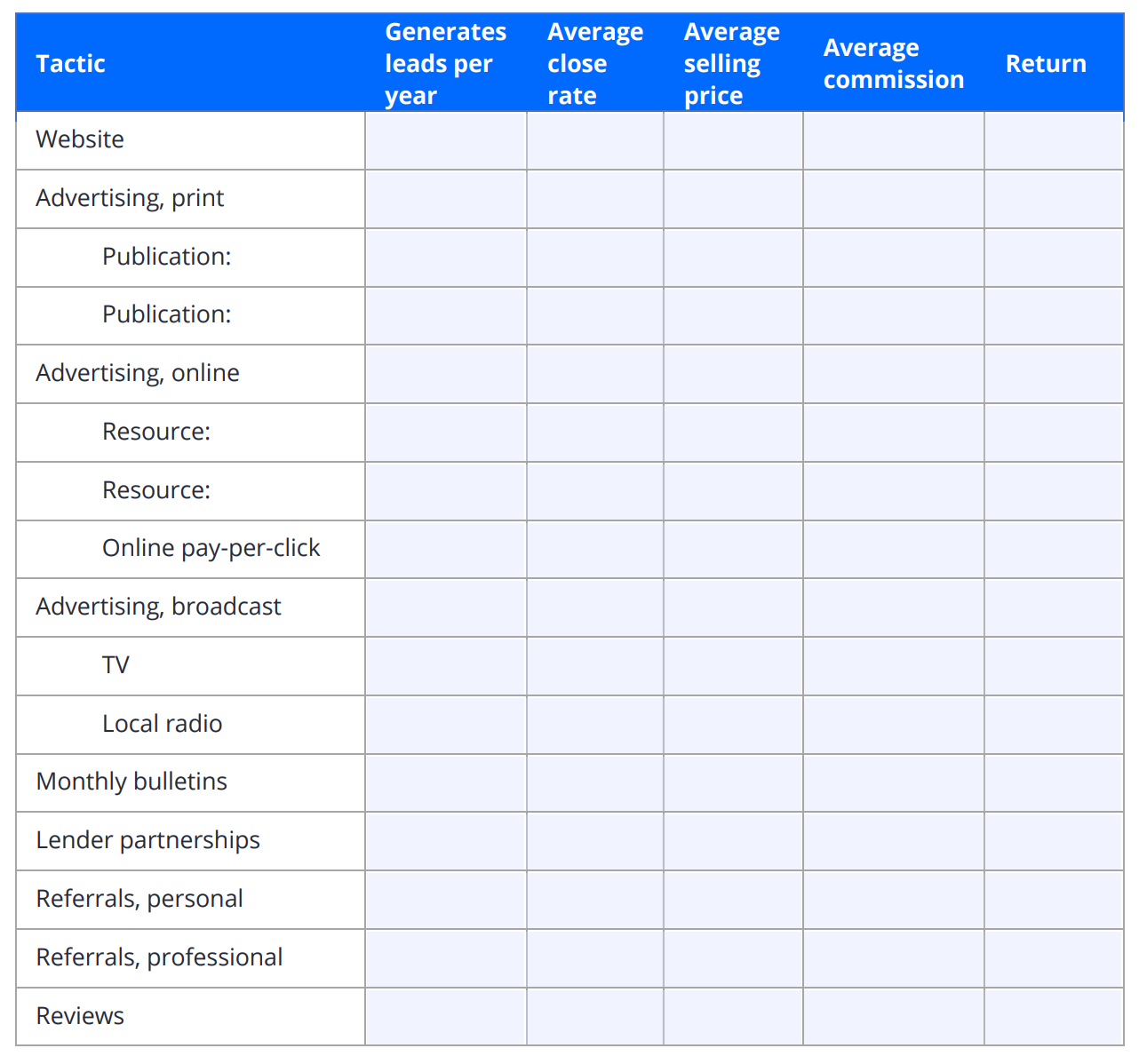
You can calculate the return using this formula:
Example: [(360 x 0.025) x $250,000] x 0.03 = $67,500
The return on online lead generation is calculated using the close rate, which ranges from 0.02% to 0.04%. In the example above, we use a close rate on the low end of the range (0.025), 360 for the number of leads generated in a year, $250,000 for the average selling price and 3% for the average commission rate.
Document ways to convert leads
Lead conversion is when you turn leads into clients. This is typically achieved through your marketing efforts. Keep track of your real estate marketing ideas and document which ones work and which ones can be improved — and then create a strategy for capitalizing on leads.
Project yearly sales forecasts
Break down what your sale types may look like for the next three years, including a forecast for referral sales, agent sales and broker sales. Example:
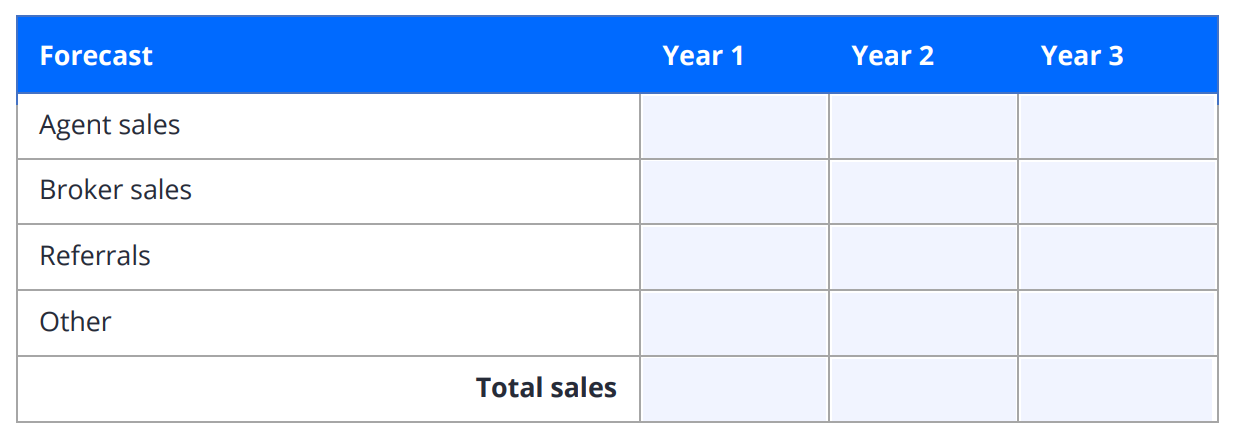
Measure client experience
Organize the services you offer and measure how quickly you’re responding to them. The goal is to build stronger client relationships. Example:

Calculate your marketing plan performance
Measuring the performance of your real estate marketing plan shows you where to focus your time and resources to meet your goals. If you track what works and what doesn’t, you can improve your strategies and tactics to see even greater returns. Example:

Free real estate marketing plan template
Use our free customizable template to create a road map to your most successful year yet! Determine your business goals, identify your customers and competition, outline a plan for generating leads and more.
Download the sample real estate marketing plan and start filling out the template today. Simply select a highlighted field and enter the information. After you populate your template, remember to update it regularly — your real estate marketing plan is a living document and your goals, tactics and measurements should be adjusted over time.
Download


